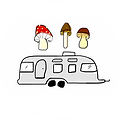Interested in learning to forage wild mushrooms?
First and foremost -- Where will you be foraging?

There are plenty of field guides that cover a wide variety of mushroom species, but the best thing to do is hone in on your specific foraging location. For instance, I bought Walter E. Sturgeon's Appalachian Mushrooms, knowing the bulk of my foraging would start in the Appalachian region.
Specifying your area helps narrow down the vast world of fungi, presenting the mushrooms you're more likely to encounter in your area.
Once you've covered your location niche, it is helpful to have a more broad resource. For example, my first foraging books included Sturgeon's Appalachian Mushrooms field guide, as well as David Arora's All that the Rain Promises and More and the The Audubon Society field guide to North American Mushrooms.

Arora's guide was very helpful starting out, as it's a pocket guide, small enough to carry with you on your walks. Additionally it provides an initial key to follow, allowing one to narrow down at least the genus of a species without any previous knowledge.
The Audubon Guide has been equally as helpful, but for different reasons. It actually features a huge range of mushrooms, with a great section of photographs that can start as jumping off points for any similar-looking species as well. Unfortunately though, some names are outdated, causing misinformation.

As a general rule of thumb, be sure you select the MOST RECENT editions of any field guides as mycology is known to be constantly evolving and many species are frequently re-named or even recently discovered!
*NOTE* PLEASE consider supporting your local bookstore rather than ordering field guides from Amazon or other large E-commerce corporations.

Once you've got a handle on a broad understanding of mushrooms, a great next step is to dive into a type!
Just like with trees where we have "Oaks" and "Pines" as broad terms for a multitude of species within a type, mushrooms have umbrella terms that encompass groups as well.
Featured to the left is a field guide by William C. Roody and Alan & Arleen Bessette with an extensive key to "Bolete" mushrooms which generally refers to mycorrhizal cap + stipe mushrooms with a spongey porous fertile surface. Narrowing your scope to Boletes and Eastern North America provides a great platform to really start to understand specific species and their characteristics.
Beyond Books there is a huge world of fungi resources online, however there is also loads of misinformation. Here are two reliable online resources I've found very helpful:
Beyond that, I would still recommend joining Facebook Groups, Reddit threads and more to simply be exposed to discourse and photos; though please note that identifications/information may be inaccurate. But with that said, exposure to photos and conversations about identification can be extremely helpful! Additionally, I like to use the Google Photos app sometimes as starting off point for identification with any fungi if I'm ever feeling stumped... though I can't iterate enough that these apps should not be trusted for anyone who is new to foraging and plan on consuming the mushroom! Mushrooms are extremely versatile and hate being put into the tidy nomenclature boxes we try to squeeze them into; therefore any software for identifying mushrooms cannot be considered ultimately reliable.
Let us know if you have any questions or suggestions! Happy foraging 🍄
.png)









Yorumlar